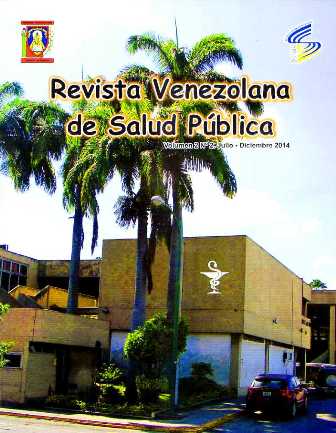Clinical and epidemiologic characterization of community acquired pneumonia. hospital "dr Israel Ranuarez Balza" Guárico. 2009-2010.
Keywords:
Pneumonia, Community, Lung diseaseAbstract
The community-acquired pneumonia are those infections developed lung parenchyma within the general population. In the World is one of the most frequent causes of medical care, a current estimated incidence in the adult population of 2-10 year 1,000 population cases. That is why this research, which aims to characterize clinically and epidemiologically to community-acquired pneumonia arises. "Dr. Israel Ranuarez Balza "State Guárico. 2009-2010. An observational, descriptive, cross-sectional study where 138 stories, of which he took only included in the study 77 was used in the investigation, which had discharge diagnosis of pneumonia acquired in the community who had the inclusion criteria . The data were processed using the statistical package SPSS version 13.0. Obtained as important findings that is more common community-acquired pneumonia in males (63.64%) and in the age group of 25-44 years (40.26%), the most relevant findings are respiratory rate ≥ 20 rpm (78%), leukocytes ≥ 11,000 mm3 (60%), creatinine ≥ 1,2mgs / dl (44%), the most common radiologic localization are infiltrates in the lower lobes (48%) and multiple foci (26%)
Downloads
References
2. Laterre PF. Severe community acquired pneumonia update: mortality, mechanisms and medical intervention. Critical Care. 2008; 12(Supl 6): S1. PubMed; PMID: 19105794
3. Sociedad Venezolana de Neumonología y Cirugía de Tórax, Pautas para el diagnostico y tratamientos de neumonías, EPOC y tuberculosis. Octubre de 2005.
4. Ministerio de salud y Desarrollo Social. Anuario de Mortalidad, Venezuela, 2005.
5. Martínez R, Valles J, Reyes S, Menéndez R. Neumonía adquirida en la comunidad: Epidemiología, factores de riesgo y pronóstico. España. 2006.
6. Black ER, Mushlin . Predecir la necesidad de hospitalización en paciente con NAC. Sep. 1991. 6(5): 394-400
7. Mac Farlane JT, Finch RG, Ward MJ, McGrae AD. Hospital study of adult community-acquired pneumonia. 1982.
8. Fine M, Stone R, Singer D. Resultados de cuidados para pacientes con NAC., Arch. Inter. Med. 1999.
9. British Thoracic Society (BTS) Standards of Care Comminettee. British Thoracic Society guidelines for the management of community acquired pneumonia in adults. Thorax. 2001; 56 (4): 1-64
10. Marrie TJ. Semin Pneumococcal pneumonia: epidemiology and clinical features. Semin Respir Infect .1999; 14(3):227-36
11. Leroy O, Santre C, Beuscart C, Georges H, Guery B, Jacquier JM, Et al. A five-year study of severe community-acquired pneumonia with emphasis on prognosis in patients admitted to an intensive care unit. Intensive Care Med. 1995. 21:24-31
12. Woodhead M, Mac Farlane J, McCracken J. Prospective study of the aetiology and outcome of pneumonia in the comunity. Lancet. 1987. 1:671-4.
13. Spiteri MA, Cook DG, Clarke SW. Reliability of eliciting physical signs in examination of the chest. Lancet. 1988
Published
How to Cite
Issue
Section
Derechos del/de autor/es a partir del año de publicación
Esta obra está bajo la licencia:
Creative Commons Reconocimiento-NoComercial-CompartirIgual 4.0 Internacional (CC BY-NC-SA 4.0)
Las opiniones expresadas por los autores no necesariamente reflejan la postura del editor de la publicación ni de la UCLA. Se autoriza la reproducción total o parcial de los textos aquí publicados, siempre y cuando se cite la fuente completa y la dirección electrónica de esta revista. Los autores(as) tienen el derecho de utilizar sus artículos para cualquier propósito siempre y cuando se realice sin fines de lucro. Los autores(as) pueden publicar en internet o cualquier otro medio la versión final aprobada de su trabajo, luego que esta ha sido publicada en esta revista.



